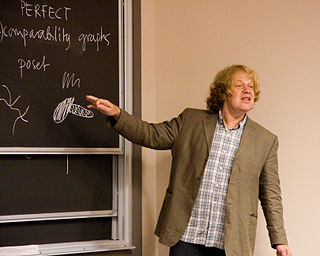Combinatorics is an area of mathematics primarily concerned with counting, both as a means and an end in obtaining results, and certain properties of finite structures. It is closely related to many other areas of mathematics and has many applications ranging from logic to statistical physics and from evolutionary biology to computer science.

Discrete mathematics is the study of mathematical structures that can be considered "discrete" rather than "continuous". Objects studied in discrete mathematics include integers, graphs, and statements in logic. By contrast, discrete mathematics excludes topics in "continuous mathematics" such as real numbers, calculus or Euclidean geometry. Discrete objects can often be enumerated by integers; more formally, discrete mathematics has been characterized as the branch of mathematics dealing with countable sets. However, there is no exact definition of the term "discrete mathematics".
Combinatorics is a branch of mathematics concerning the study of finite or countable discrete structures.

Discrete geometry and combinatorial geometry are branches of geometry that study combinatorial properties and constructive methods of discrete geometric objects. Most questions in discrete geometry involve finite or discrete sets of basic geometric objects, such as points, lines, planes, circles, spheres, polygons, and so forth. The subject focuses on the combinatorial properties of these objects, such as how they intersect one another, or how they may be arranged to cover a larger object.

Béla Bollobás FRS is a Hungarian-born British mathematician who has worked in various areas of mathematics, including functional analysis, combinatorics, graph theory, and percolation. He was strongly influenced by Paul Erdős since the age of 14.

The no-three-in-line problem in discrete geometry asks how many points can be placed in the grid so that no three points lie on the same line. The problem concerns lines of all slopes, not only those aligned with the grid. It was introduced by Henry Dudeney in 1900. Brass, Moser, and Pach call it "one of the oldest and most extensively studied geometric questions concerning lattice points".

Jaroslav (Jarik) Nešetřil is a Czech mathematician, working at Charles University in Prague. His research areas include combinatorics, graph theory, algebra, posets, computer science.

In graph theory, the strong product is a way of combining two graphs to make a larger graph. Two vertices are adjacent in the strong product when they come from pairs of vertices in the factor graphs that are either adjacent or identical. The strong product is one of several different graph product operations that have been studied in graph theory. The strong product of any two graphs can be constructed as the union of two other products of the same two graphs, the Cartesian product of graphs and the tensor product of graphs.

Algebraic combinatorics is an area of mathematics that employs methods of abstract algebra, notably group theory and representation theory, in various combinatorial contexts and, conversely, applies combinatorial techniques to problems in algebra.

János Pach is a mathematician and computer scientist working in the fields of combinatorics and discrete and computational geometry.
Heiko Harborth is Professor of Mathematics at Braunschweig University of Technology, 1975–present, and author of more than 188 mathematical publications. His work is mostly in the areas of number theory, combinatorics and discrete geometry, including graph theory.
Norman Linstead Biggs is a leading British mathematician focusing on discrete mathematics and in particular algebraic combinatorics.

Richard M. Pollack was an American geometer who spent most of his career at the Courant Institute of Mathematical Sciences at New York University, where he was Professor Emeritus until his death.

In graph drawing and geometric graph theory, the slope number of a graph is the minimum possible number of distinct slopes of edges in a drawing of the graph in which vertices are represented as points in the Euclidean plane and edges are represented as line segments that do not pass through any non-incident vertex.

In the mathematical field of graph theory, the queue number of a graph is a graph invariant defined analogously to stack number using first-in first-out (queue) orderings in place of last-in first-out (stack) orderings.

Ian Murray Wanless is a professor in the School of Mathematics at Monash University in Melbourne, Australia. His research area is combinatorics, principally Latin squares, graph theory and matrix permanents.

The Combinatorial Mathematics Society of Australasia (CMSA) is a professional society of mathematicians working in the field of combinatorics. It is the primary combinatorics society for Australasia, consisting of Australia, New Zealand and neighbouring countries. The CMSA existed as an informal group from 1972 until formal establishment in 1978. It became an incorporated association in 1996, and as of 2017, it has over 280 members including 110 life members.

Anne Penfold Street (1932–2016) was one of Australia's leading mathematicians, specialising in combinatorics. She was the third woman to become a mathematics professor in Australia, following Hanna Neumann and Cheryl Praeger. She was the author of several textbooks, and her work on sum-free sets became a standard reference for its subject matter. She helped found several important organizations in combinatorics, developed a researcher network, and supported young students with interest in mathematics.
Catherine Greenhill is an Australian mathematician known for her research on random graphs, combinatorial enumeration and Markov chains. She is a professor of mathematics in the School of Mathematics and Statistics at the University of New South Wales, and an editor-in-chief of the Electronic Journal of Combinatorics.
Jeanette Claire McLeod is a New Zealand mathematician specialising in combinatorics, including the theories of Latin squares and random graphs. She is a senior lecturer in the School of Mathematics and Statistics at the University of Canterbury, a principal investigator for Te Pūnaha Matatini, a Centre of Research Excellence associated with the University of Auckland, an honorary senior lecturer at the Australian National University, and the president for three terms from 2018 to 2020 of the Combinatorial Mathematics Society of Australasia.














